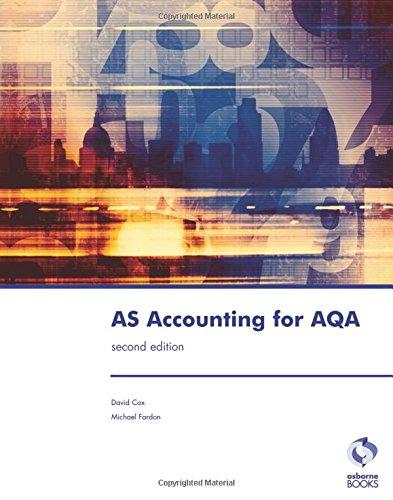Question
The first table gives the present value of $1 at the end of different time periods, given different interest rates. For example, at an interest
The first table gives the present value of $1 at the end of different time periods, given different interest rates. For example, at an interest rate of 10%, the present value of $1 to be paid in 20 years is $0.149. At 10% interest, the present value of $1,000 to be paid in 20 years equals $1,000 times 0.149, or $149. The second table gives the present value of a stream of payments of $1 to be made at the end of each period for a given number of periods. For example, at 10% interest, the present value of a series of $1 payments, made at the end of each year for the next 10 years, is $6.145. Using that same interest rate, the present value of a series of 10 payments of $1,000 each is $1,000 times 6.145, or $6,145.
Table 13.3 Present Value of $1 to Be Received at the End of a Given Number of Periods
| Percent Interest | ||||||||||
|---|---|---|---|---|---|---|---|---|---|---|
| Period | 2 | 4 | 6 | 8 | 10 | 12 | 14 | 16 | 18 | 20 |
| 1 | 0.980 | 0.962 | 0.943 | 0.926 | 0.909 | 0.893 | 0.877 | 0.862 | 0.847 | 0.833 |
| 2 | 0.961 | 0.925 | 0.890 | 0.857 | 0.826 | 0.797 | 0.769 | 0.743 | 0.718 | 0.694 |
| 3 | 0.942 | 0.889 | 0.840 | 0.794 | 0.751 | 0.712 | 0.675 | 0.641 | 0.609 | 0.579 |
| 4 | 0.924 | 0.855 | 0.792 | 0.735 | 0.683 | 0.636 | 0.592 | 0.552 | 0.515 | 0.442 |
| 5 | 0.906 | 0.822 | 0.747 | 0.681 | 0.621 | 0.567 | 0.519 | 0.476 | 0.437 | 0.402 |
| 10 | 0.820 | 0.676 | 0.558 | 0.463 | 0.386 | 0.322 | 0.270 | 0.227 | 0.191 | 0.162 |
| 15 | 0.743 | 0.555 | 0.417 | 0.315 | 0.239 | 0.183 | 0.140 | 0.180 | 0.084 | 0.065 |
| 20 | 0.673 | 0.456 | 0.312 | 0.215 | 0.149 | 0.104 | 0.073 | 0.051 | 0.037 | 0.026 |
| 25 | 0.610 | 0.375 | 0.233 | 0.146 | 0.092 | 0.059 | 0.038 | 0.024 | 0.016 | 0.010 |
| 40 | 0.453 | 0.208 | 0.097 | 0.046 | 0.022 | 0.011 | 0.005 | 0.003 | 0.001 | 0.001 |
| 50 | 0.372 | 0.141 | 0.054 | 0.021 | 0.009 | 0.003 | 0.001 | 0.001 | 0 | 0 |
Table 13.4 Present Value of $1 to Be Received at the End of Each Period for a Given Number of Periods
| Percent Interest | ||||||||||
|---|---|---|---|---|---|---|---|---|---|---|
| Period | 2 | 4 | 6 | 8 | 10 | 12 | 14 | 16 | 18 | 20 |
| 1 | 0.980 | 0.962 | 0.943 | 0.926 | 0.909 | 0.893 | 0.877 | 0.862 | 0.847 | 0.833 |
| 2 | 1.942 | 1.886 | 1.833 | 1.783 | 1.736 | 1.690 | 1.647 | 1.605 | 1.566 | 1.528 |
| 3 | 2.884 | 2.775 | 2.673 | 2.577 | 2.487 | 2.402 | 2.322 | 2.246 | 2.174 | 2.106 |
| 4 | 3.808 | 3.630 | 3.465 | 3.312 | 3.170 | 3.037 | 2.910 | 2.798 | 2.690 | 2.589 |
| 5 | 4.713 | 4.452 | 4.212 | 3.993 | 3.791 | 3.605 | 3.433 | 3.274 | 3.127 | 2.991 |
| 10 | 8.983 | 8.111 | 7.360 | 6.710 | 6.145 | 5.650 | 5.216 | 4.833 | 4.494 | 4.192 |
| 15 | 12.849 | 11.718 | 9.712 | 8.559 | 7.606 | 6.811 | 6.142 | 5.575 | 5.092 | 4.675 |
| 20 | 16.351 | 13.590 | 11.470 | 9.818 | 8.514 | 7.469 | 6.623 | 5.929 | 5.353 | 4.870 |
| 25 | 19.523 | 15.622 | 12.783 | 10.675 | 9.077 | 7.843 | 6.873 | 6.097 | 5.467 | 4.948 |
| 30 | 22.396 | 17.292 | 13.765 | 11.258 | 9.427 | 8.055 | 7.003 | 6.177 | 5.517 | 4.979 |
| 40 | 27.355 | 19.793 | 15.046 | 11.925 | 9.779 | 8.244 | 7.105 | 6.233 | 5.548 | 4.997 |
| 50 | 31.424 | 21.482 | 15.762 | 12.233 | 9.915 | 8.304 | 7.133 | 6.246 | 5.554 | 4.999 |
QUESTION: Mark Jones is thinking about going to college. If he goes, he will earn nothing for the next four years and, in addition, will have to pay tuition and fees totaling $10,000 per year. He also would not earn the $25,000 per year he could make by working full time during the next four years. After his four years of college, he expects that his income, both while working and in retirement, will be $20,000 per year more, over the next 50 years, than it would have been had he not attended college. Should he go to college? Assume that each payment for college and dollar of income earned occur at the end of the years in which they occur. Ignore possible income taxes in making your calculations. Decide whether you should attend college, assuming each of the following interest rates:
A) 2%
B) 4%
C) 6%
D) 8%
Step by Step Solution
There are 3 Steps involved in it
Step: 1

Get Instant Access to Expert-Tailored Solutions
See step-by-step solutions with expert insights and AI powered tools for academic success
Step: 2

Step: 3

Ace Your Homework with AI
Get the answers you need in no time with our AI-driven, step-by-step assistance
Get Started


